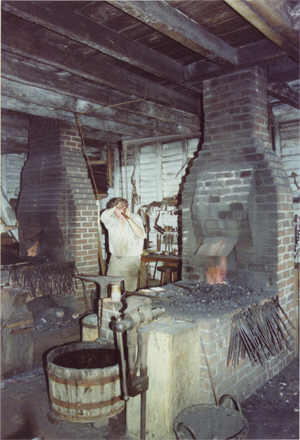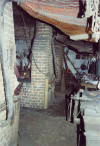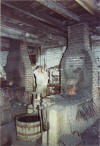 James
Anderson Blacksmith Shop
James
Anderson Blacksmith ShopColonial Williamsburg, Williamsburg, Virginia
[Home] [Back to Coal Forge 1] [Alte Schmiede] [Gmünd, Austria] [Anderson Blacksmith, Colonial Williamsburg, VA] [Quasdorf Blacksmith, Dows, Iowa] [Matthew Edel, Haverhill, Iowa]
UPDATED September 16th, 2019.
 James
Anderson Blacksmith Shop
James
Anderson Blacksmith ShopColonial Williamsburg, Williamsburg, Virginia, USA. 1993.
James Anderson was a blacksmith in Williamsburg Virginia during the American war with Britain. From 1762 until 1780, Anderson operated a smithy in Williamsburg making and repairing iron tools and implements. In addition to his blacksmith business, he was also public armorer beginning in 1766. In 1780 he moved his business to Richmond, Virginia, when the seat of government was moved to that city.
Updated September 16, 2019.
Anderson ran a successful and growing business and accordingly he added additional workshop space and forges. There are a total of 7 forges in the Anderson blacksmith shop. The focus of this page is on the brick and timber hooded style forge and two of the brick side-draft style forges - all of which are located in the 'new' larger annex in the rear of the Anderson shop. In addition to the 3 forges shown on this page, there is also a large enclosed medieval style brick forge that is out of sight behind the camera man. Two more enclosed medieval style forges are in an older part of the shop that is also behind the camera man, and another (possibly side-draft forge?) is just barely visible through the doorway to another room behind the blacksmiths working at the side-draft forges in these photos. The chimney is just barely visible behind one of the blacksmiths. See if you can find it.
Anderson employed journeyman gunsmiths and blacksmiths, and he also employed nail makers and up to 9 apprentices at one time. With 7 fires lit, this was a very busy blacksmith shop.
Want to see these forges being used by real blacksmiths? Check out the two videos filmed at Colonial Williamsburg and described near the bottom of this page.


 Historical
recreation of Anderson's original smithy. Like many other old
buildings, the original Anderson's blacksmith shop had long since
disappeared. Archeologists and architectural historians reconstructed the
outline of the Anderson shop after studying the excavation of the original
workshop site. The Anderson blacksmith shop today at Colonial Williamsburg
is a hand-made reconstruction of that original shop. After careful study,
local craftsmen reconstructed not only the building, but the forges in the
style common of the era and possibly very similar to what actually was
built in the original workshop.
Historical
recreation of Anderson's original smithy. Like many other old
buildings, the original Anderson's blacksmith shop had long since
disappeared. Archeologists and architectural historians reconstructed the
outline of the Anderson shop after studying the excavation of the original
workshop site. The Anderson blacksmith shop today at Colonial Williamsburg
is a hand-made reconstruction of that original shop. After careful study,
local craftsmen reconstructed not only the building, but the forges in the
style common of the era and possibly very similar to what actually was
built in the original workshop.
Hooded style forge: (Photos at right) The hearth measures roughly 4 feet square - large and very comfortable to work with. The chimney and large corbelled hood all made of brick. Corbelling of the hood and the gentle sloping entrance into the chimney are covered with mortar plaster to smooth their surface and appearance. A timber lintel supports the hood and is held up by wrought iron rods fixed into the masonry. The hood is located high above the fire and drafts on a windy day can blow smoke into the shop. In the photo (far right) the smith is pulling the rope to operate the bellows. The bellows are located overhead and behind the forge so that they take up less workspace.


 Side-draft
or hoodless style forges: (Photos at right) "Hoodless forge" refers to
a chimney design that does not use a large overbearing hood above the
fire, though it is common to see a very small sheet iron shroud and a
little bit of brick corbelling above the fire to help guide the smoke into
the chimney. "Side-draft" describes specifically the action or way that
this style of chimney works - smoke entering the chimney sideways through
an opening near the fire. Two hoodless forges are built side by side in
the large shop annex. Both forges (photo middle right) have small sheet
metal shrouds above the flames of the fire, to help guide smoke into the
chimneys. The corbelling appears to be more decorative than useful because
it does not appear to guide smoke into the chimney, however the corbeling
might indicate the shape of the inside of the chimneys. The hearths
appeared to be roughly 4 foot square. Bellows are all located overhead and
behind the forges, with levers extending over the smiths heads and pull
ropes attached to the ends of the bellows levers so that the smiths can
easily pump the bellows while standing near their fires. A hole built at
hearth-level into the backs of each chimney provides access to the fire
pits and tuyeres and connections with the air blast pipes from the
bellows. Photo near right- detail of one of the great bellows mounted
overhead. Photo middle right- blacksmith pulling the overhead rope or
lever to pump the bellows for his fire. Photo far right- view behind the
forges.
Side-draft
or hoodless style forges: (Photos at right) "Hoodless forge" refers to
a chimney design that does not use a large overbearing hood above the
fire, though it is common to see a very small sheet iron shroud and a
little bit of brick corbelling above the fire to help guide the smoke into
the chimney. "Side-draft" describes specifically the action or way that
this style of chimney works - smoke entering the chimney sideways through
an opening near the fire. Two hoodless forges are built side by side in
the large shop annex. Both forges (photo middle right) have small sheet
metal shrouds above the flames of the fire, to help guide smoke into the
chimneys. The corbelling appears to be more decorative than useful because
it does not appear to guide smoke into the chimney, however the corbeling
might indicate the shape of the inside of the chimneys. The hearths
appeared to be roughly 4 foot square. Bellows are all located overhead and
behind the forges, with levers extending over the smiths heads and pull
ropes attached to the ends of the bellows levers so that the smiths can
easily pump the bellows while standing near their fires. A hole built at
hearth-level into the backs of each chimney provides access to the fire
pits and tuyeres and connections with the air blast pipes from the
bellows. Photo near right- detail of one of the great bellows mounted
overhead. Photo middle right- blacksmith pulling the overhead rope or
lever to pump the bellows for his fire. Photo far right- view behind the
forges.
Work benches and tool storage. Work benches along the walls in the large 'new' annex get plenty of natural light from nearby windows during daytime. Large vises are mounted to heavy timbers set deep in the ground near the forges. The smiths mounted their vises to the wooden timbers rather than the solid brick of the forge because if the vise were mounted to solid masonry of the forge structure, the concussion from pounding on the vise would quickly tear itself out of the mounting holes in the masonry. The heavy timber buried deep in the earth, offers substantial stability to the vise while the smith is twisting and bending and pounding on work in the vise. Small timber frames built behind the forges offer storage space for hardies and other tools. In front of each forge is a water barrel for cooling the iron, the barrels neatly tucked into the little space between the vise mounting posts and front of the forge hearths.

 Before
building the Anderson Blacksmith shop, the blacksmiths at Colonial
Williamsburg worked out of the ground floor of the harness maker's shop -
the Dean Shop. The forge in the Dean Shop was a fully enclosed medieval
style forge made of brick, similar to a fireplace hearth that is raised up
to the level of a dinner table. Examples of some of the small historical
reproduction items made by these blacksmiths are displayed on the table
near the lower edges of the photos (photos at right).
Before
building the Anderson Blacksmith shop, the blacksmiths at Colonial
Williamsburg worked out of the ground floor of the harness maker's shop -
the Dean Shop. The forge in the Dean Shop was a fully enclosed medieval
style forge made of brick, similar to a fireplace hearth that is raised up
to the level of a dinner table. Examples of some of the small historical
reproduction items made by these blacksmiths are displayed on the table
near the lower edges of the photos (photos at right).

 A
Medieval Style Enclosed Forge: (Click on the thumbnail photos at
right) This enclosed style forge adds an almost "cozy" atmosphere to the
shop. The forge is enclosed on three sides by the masonry walls of the
hood and chimney. Although the forge appears too small for heating long
bars of iron in their middles, long bars can in fact be heated by first
passing one end of the bar through a small hole built into the rear of the
masonry hood.
A
Medieval Style Enclosed Forge: (Click on the thumbnail photos at
right) This enclosed style forge adds an almost "cozy" atmosphere to the
shop. The forge is enclosed on three sides by the masonry walls of the
hood and chimney. Although the forge appears too small for heating long
bars of iron in their middles, long bars can in fact be heated by first
passing one end of the bar through a small hole built into the rear of the
masonry hood.

Two
videos were filmed for television on location at the blacksmith shops
in Colonial Williamsburg. Both videos are available from the gift shop at
Colonial Williamsburg, and also from Centaur Forge.
Hammerman in Williamsburg, produced in 1973 and filmed in the Dean Shop at Colonial Williamsburg. Hammerman in Williamsburg is a fictional portrayal of the life of a colonial era blacksmith, with John Allgood forging items and repairs needed for daily life during that era. The enclosed medieval style forge is used in this video.
Forged In Wood - Building Anderson's Blacksmith Shop, chronicles the archeology and building of the Anderson's Blacksmith shop at Colonial Williamsburg during the mid-1980's, as a reproduction of the original building the way historians believe it appeared more than two centuries ago. Three of the forges on this webpage (the large hooded forge and two of the hoodless forges) are used in this video.
Colonial Williamsburg is open all year round and is located in Williamsburg, Virginia, USA. Colonial Williamsburg website : http://www.history.org/ . The museum has many other master craftsman and tradesman offering a realistic example of how people lived and worked during the colonial era in America. Visitors should plan to have at least one full day for a visit.
Information about James Anderson - The Blacksmith in Eighteenth-Century Williamsburg. Williamsburg Craft Series booklet published by Colonial Williamsburg, and available at the Colonial Williamsburg gift shop.
Updated September 16, 2019.
Original published April 22nd, 1999.
Readers who have knowledge or documentation on this shop are invited to mail the author at the email address below.
Latest update September 16, 2019.
The author can be emailed at address in picture below: